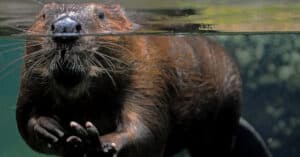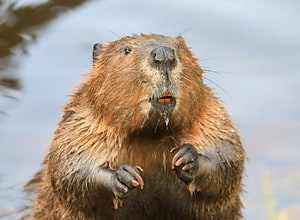Beavers are semi-aquatic animals that build their lodges or burrows on the edge of riverbanks or in the middle of rivers. They are ecosystem changers and bring positive and negative consequences to their environment. Over thousands of years, beavers’ sleep patterns have been affected by predators, even though they face much less predation today. But are beavers nocturnal or diurnal? This article investigates the sleep behavior of beavers to discover whether they are nocturnal, diurnal, or demonstrate another activity behavior.
Beavers have Nocturnal and Crepuscular Tendencies
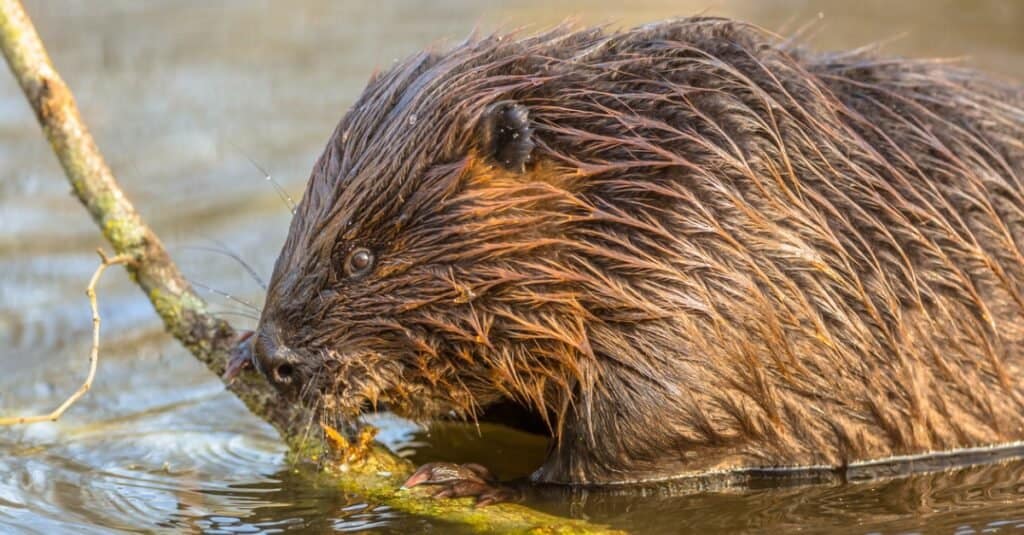
Typically beavers are nocturnal but have crepuscular tendencies.
©iStock.com/CreativeNature_nl
Beavers are generally nocturnal, so they are primarily active from 5 p.m. to 8 a.m., spending the rest of the day in their lodges. This activity pattern is somewhat unexpected and may not be optimal for various reasons. The thermal energy hypothesis suggests that all endothermic animals in the temperate zone will benefit from a diurnal lifestyle. This belief is because the daily activity of endothermic animals has lower energy demands than nighttime activity.
Beavers also have crepuscular tendencies, which means they are active at dusk and dawn. Diurnal animals sleep at night, and nocturnal animals sleep during the day. Most nocturnal animals have adapted this pattern of activity based on external factors like low predator potential or easy access to food. Some animals that prey on beavers include coyotes, foxes, and bears. Many of these animals are diurnal, which makes it an advantage to be a nocturnal beaver.
Beavers are Nocturnal Due to Predation
As herbivores, beavers do not restrict themselves to feeding at certain times of the day. Given the potential benefits of daytime activity for beavers, it is likely that predatory pressure has shaped and continues to shape their nighttime activity pattern. For instance, the Eurasian beaver was once preyed upon in western Europe by three large predators: the wolf, brown bear, and lynx.
But, like beavers, these predators have been wiped out from much of their western European landscape. And although predator populations have increased in recent years, they are still small in areas where beavers have recolonized.
Historically, humans have hunted beavers. Archaeological evidence suggests that prehistoric hunter-gatherers targeted beavers. More recently, human hunting has been responsible for their near extinction. Where legal, humans are still their main predators. Fortunately, beavers are now heavily protected in much of western Europe, with no hunting or trapping allowed.
Beaver activity patterns in predator-free landscapes resemble beaver populations in more natural predatory ecosystems. This activity suggests that it is not current predatory pressure that causes beavers to confine their busiest times to the twilight and nighttime hours. Hunter-gatherers have targeted beavers since the Pleistocene age, but recent human persecution has nearly wiped out the Eurasian beaver. Although humans don’t hunt beavers in many areas, the effects of human persecution remain on their activity patterns.
Beavers Rely on their Smell and Hearing
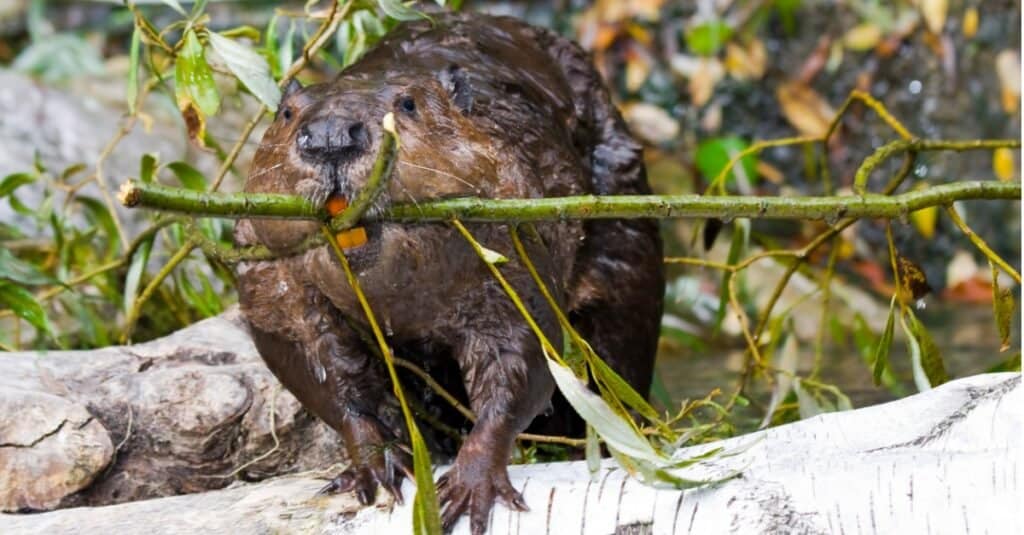
Beavers rely on their smell and hearing because they do not have advanced night vision.
©iStock.com/belizar73
Many nocturnal and crepuscular animals have good night vision as they need to see during moonlight or completely dark evenings. Beavers lack the tapetum lucidum in their eyes. The tapetum lucidum is an intraocular reflex membrane that is an essential adaptation for night vision. Due to their poor eyesight, they move slowly on land, rarely more than 20 feet from the water.
Beavers have a nictitating membrane, like a third transparent “eyelid,” to protect their eyes. These animals are excellent swimmers who can swim underwater for more than ten minutes. What they lack in their eyesight, they make up for with their swimming abilities. Webbed feet and paddle-shaped tails help them move effortlessly through the water. Because of this, beavers rely on their strong sense of smell and hearing to navigate the darkness on land.
Beavers rely heavily on their sense of smell and hearing. They may have small ears, but beavers have an excellent ability to perceive sounds. These animals have much larger auditory cavities than humans. Large ear organs help detect small sounds in the air and water. Water conducts sounds better than air, meaning beavers can hear much better underwater. To keep water out of their ears, they have valves that cover their ear canals. Beavers use their noses to find food, predators, and colony members because it is probably their most developed sense.
Where do Beavers Sleep?
Beavers are semi-aquatic. Being semi-aquatic means they live on land and in water. The ideal habitat for beavers is freshwater bodies surrounded by forests. Beavers build lodges out of wood chips, twigs, and dirt in the middle of beaver-made ponds or river banks. They access their lodge through a water-filled tunnel that protects them from predators. Beavers eat, sleep, keep warm and raise their young in their lodge. They also store food in their lodges to see them through the winter.
However, beavers do not always live in lodges and sometimes prefer to live in extensive burrows that they dig on the banks of rivers whenever possible. These burrows can span many feet and contain one or more chambers. Burrows usually have one or more entrances underwater.
Daily Routine of Beavers
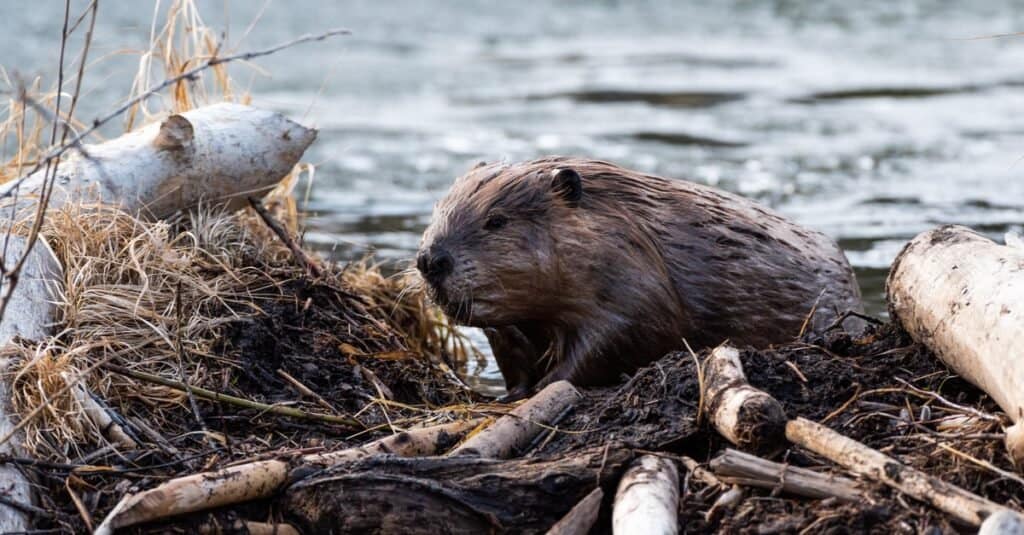
Beavers build their lodges on the side of a riverbank or in the middle of ponds.
©Dan-Pepper/Shutterstock.com
During the daytime, beavers sleep inside their lodges. Once it becomes dusk, the beavers wake and start foraging for food or wood to add to their lodgings. During the nighttime, beavers continue feeding and building but are not as active as they are during dusk.
Beavers are generally more active on bright nights than on dark nights. This activity contrasts with the most commonly reported pattern of reduced activity in mammals under bright moonlight due to increased predation risk. Also, this behavior may be because beavers have a higher foraging success rate in bright moonlight. Beavers also boost their activity once it becomes dawn before going to sleep again.
Beavers change ecosystems due to their nocturnal activity. They are known to build dams and create ponds. This transformation has various consequences. Researchers believe the positive effects of their activity lead to a reduction in the number of forest fires, an increase in recultivation rates, retention of pollutants by dams, and an increase in the biodiversity of aquatic and wet-loving species.
Negative impacts due to their activity are lack of oxygen in beaver ponds, fish mortality, high carbon concentrations, and vegetation dieback below the dam due to a lack of oxygen and above the dam due to over-wetting.
Beavers do not Hibernate
Beavers do not hibernate during the winter. They lower their body temperature to conserve energy and survive the cold season. But this means that they need to have a constant supply of food. Most living plants are dormant, and trees do not transport sap through their bark during the cold months. This dormancy in plants is why beavers store food for the winter.
Beavers always live in dwellings with underwater entrances, either in burrows dug in the banks of streams or lodges made by themselves from branches. Underwater openings allow them to enter and exit their dwellings undetected. Nevertheless, ice formations in the winter can limit movement above the water’s surface.
Members of the colony start stockpiling food for the winter. They take down many trees, cut off branches, and drag them along well-trodden paths to the water’s edge. When winter ice forms, the water surface freezes, and beavers become less active and slower, spending most of their time indoors.
When they need food, beavers swim, dig up branches, and bring them to the lodge or burrow for the family to consume. They feed entirely on the tiniest twigs and buds. But as they move into the thicker parts of the branch, they eat only the bark, leaving behind the hard, indigestible heartwood.
Nocturnal vs. Diurnal: What’s The Difference?
Navigate to Nocturnal vs. Diurnal: What’s The Difference? for further information about the nocturnal and diurnal phenomenon in various living creatures.
Up Next – All About Nocturnal Beavers
The photo featured at the top of this post is © iStock.com/Christina Radcliffe
Sources
- Research Gate, Available here: https://www.researchgate.net/publication/238024514_Over-winter_activity_and_body_temperature_patterns_in_northern_beavers
- Beaver Trust, Available here: https://beavertrust.org/wp-content/uploads/2020/12/Beaver-Trust-FAQs.pdf
- University of Wisconsin, Available here: https://www3.uwsp.edu/biology/VertebrateCollection/Pages/Vertebrates/Mammals%20of%20Wisconsin/Castor%20canadensis/Castor%20canadensis.aspx
- Research Gate, Available here: https://www.researchgate.net/figure/Beaver-activity-patterns-on-nights-classified-as-Dark-and-Light-based-on-the_fig3_282633539
Thank you for reading! Have some feedback for us? Contact the AZ Animals editorial team.





